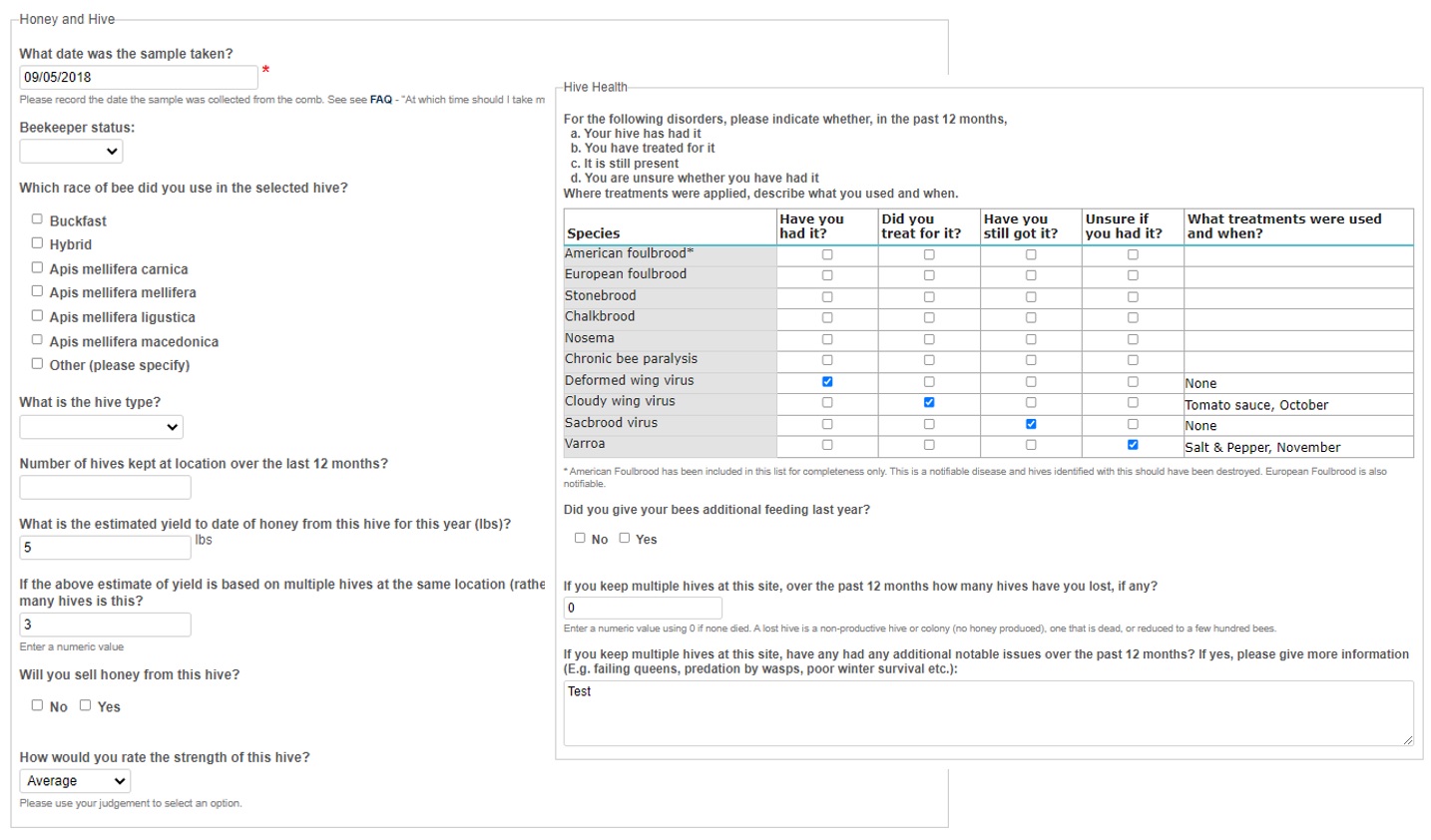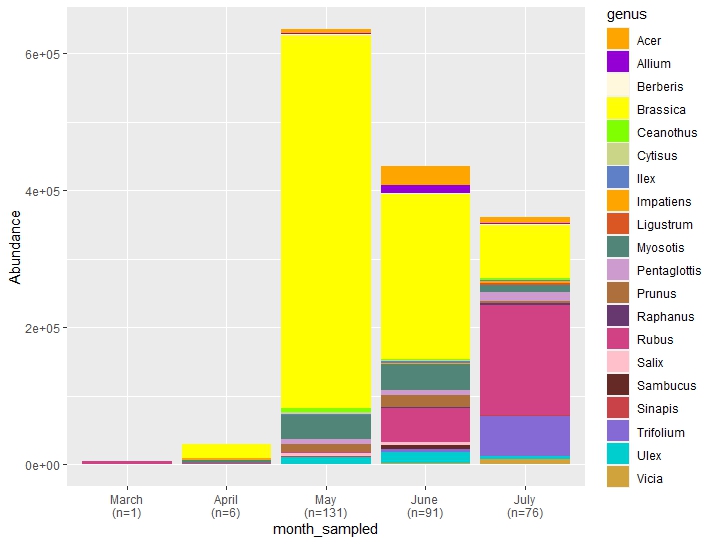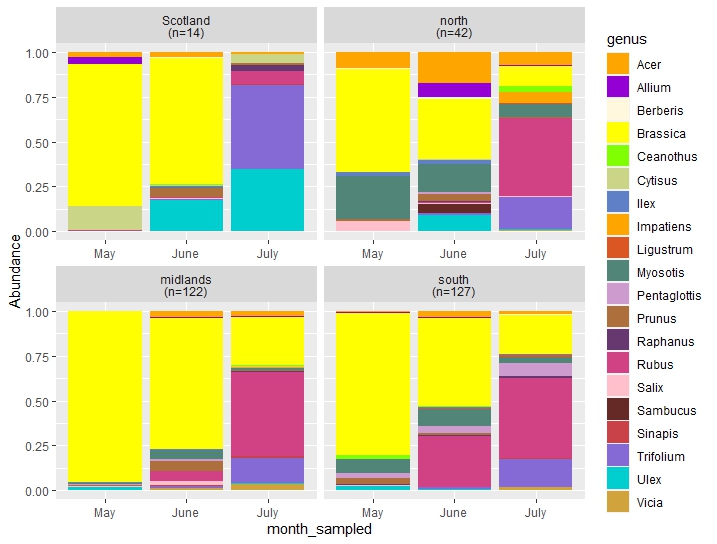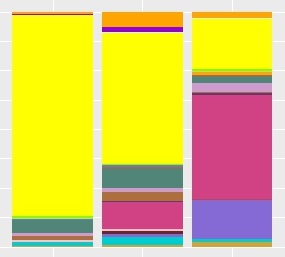Dear Beekeepers,
I hope you are well and enjoying the summer! I feel bad for being mean about my bees in the previous newsletter as the next day I checked them and they were like textbook hives - all with Queens, eggs, brood, plenty of food and calm bees. Lots of wasps, but thankfully my stack of spare boxes was acting as a decoy!
A few announcements to make in this newsletter:
2023 sample pack requests CLOSED
Due to all your super enthusiasm for taking part in the scheme, we have reached our limit for the number of sampling packs we'd planned to send out in 2023 so have closed the sample pack request option on our website. This means you will no longer be able to request a sample pack, but if you have received one already please go ahead and collect your samples and send them back to us. We're sorry to disappoint but we are managing our time and resources this year to avoid last year's sample backlog and delay in producing results.
2023 samples received
Ellie has asked me to pass on her thanks for the 400+ samples returned this year so far and your helpfulness in including wax in your samples, accompanying wax-free samples with a note to clarify they are not extracted/are from a flow hive and for filling out your online questionnaires with hive type. As I may have mentioned before, it is not the wax we need but to be sure the samples have been collected directly from the comb from a single hive, so we know the data you have provided is accurate for the honey sample. Extracted honeys may come from multiple hives, across multiple timepoints, possibly in different locations - which may affect the accuracy of our analysis - and is less likely to succeed in the pollen analysis if it has been filtered in any way.
Online questionnaire
Linked to each of your samples is an online form that asks you questions about the health, honey yield and treatment history of the hive you collected the sample from:

We made it so only a couple of these questionnaires need to be answered to submit your sample, but we would greatly appreciate it if you could take the time to fill in the remainder of the questions as this enhances the analysis we can do with the pollen and pesticide data. The compulsory questions allow us to look at the effect of hive location and sampling month on these data, but the optional questions allow us to determine whether honeybee disease, honey production and hive longevity is affected by foraging diversity and pesticide exposure. All interesting and valuable insights, as I'm sure you'll agree!
2022 results
The sequencing data for the first ~400 honey samples sent back in 2022 are currently being proofed by our plant expert before they are uploaded to the website. Please note: they have not been uploaded yet so the plant taxa section of your PDF report will still be blank. While this is being done, I thought I'd send you some summary plots of these ~400 samples.
This first plot shows the numbers of plant sequences produced for these samples, split by month the honey samples were collected. I have slimmed it down to the top 20 plant genus detected in this sequencing run as the plot becomes difficult to interpret with more!

It is common to present the above plot as proportions, rather than as sequence read numbers as I have done. However, I wished to show you that there were very few samples collected in March and April (as expected) so turning this plot into proportions could be mis-leading. I therefore exclude the seven early samples from the proportion plot to show only samples collected in May, June and July:

It is really neat to see the transition from predominantly Brassica (yellow) in May to a combination of Rubus (dusty pink) and Trifolium (purple) in July, with low-level appearances from Acer (orange), Myosotis (lilac), Pentaglottis (brown) and Ulex (turquoise) throughout.
I then thought I would break this down further by region where honey was collected from. Assuming that north-south has a greater impact than east-west, I banded the UK into Scotland, north, midlands and south:

I have again used the sequence read number plot, instead of the proportion plot, to show you that this early-season data is dominated by samples collected in the midlands and south. There are too few early samples from Scotland (n=14) to draw any meaningful conclusions at this point, but I would remark on the diversity of species in June samples collected from the north! As you can see, the migration from predominantly Brassica in May to predominantly Rubus and Trifolium in July is very much being driven by trends in the more southerly honeys.
I hope this whistle-stop tour of these results makes sense! These ~400 samples represent the first 1/3rd of the 2022 samples - I am about to do the sequencing run on the second 1/3rd and we are still extracting pollen DNA from the third 1/3rd. In the meantime, I am also working on updating the NHMS website with preliminary results like this so please keep your eyes peeled for those.
Emails
If you have sent an email to the NHMS account in the past few weeks, I am sorry that you have not yet received a reply. A combination of training courses, lab work and bioinformatics has kept me from the inbox! Jo will be taking over email responses from now on and will be getting back to you soon.
Newsletter subscription
If you are no longer interested in receiving these newsletters please scroll to the bottom of this email, click "unsubscribe from this list" and follow the instructions from there.
That turned out to be quite a chunky update! Thank you, as always, for your participation in NHMS and have a lovely weekend.
Best wishes,
Jenny
On behalf of the NHMS team
